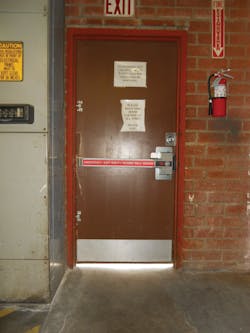Back Page, September 2021
10 Years Ago
Locksmith Ledger took a first look the E-Plex wireless electronic access control system from Kaba Access Control. Another electronics article explained the flexibility of Schlage’s scalable CO Series and AD Series locks. A more in-depth article examined the world of multicredentials, giving tips on determining which credential type was best for your customer. Ten years ago, choices involved various cards, fobs or biometrics. Smartphones weren’t yet a choice. Another article looked at Design Hardware’s 316R Series Replacement Door Closer, which has a patented mounting plate that enabled the 316R closer to retrofit 32 door closers without drilling new holes. Keedex introduced its USB Wafer Reader that uses a digital camera and computer to provide a large image of the lockface, keyway and ledger positions of the wafer. In our 30 Under 30 series, Steve Kaufman interviewed 20-year-old locksmith Fred Kuhar, just starting out in the business with Fox Chase Lock & Key in Philadelphia. Kuhar still works there today. On the automotive side, Slick Locks offered no-drill truck hasps to secure your service van without drilling through the body.
20 Years Ago
Exit alarms were on the cover of the September 2001 issue of Locksmith Ledger. Dick Zunkel wrote about the evolution and applications for exit alarms. Tim O’Leary addressed building codes and legal issues regarding exit devices and alarms. Jerry Levine reported on a retrofit installation of the Precision Hardware 1100 Apex rim exit device. Jerry Levine and Gary Williams converted a Von Duprin 99 rim exit device to an exit alarm. Another installation article asked the question “which access control device is right for your application – electric strike, electromagnetic lock or electromechanical lock?” A-1 Security introduced the Mean Green code-cutting punch machine, a workhorse for many years before A-1 went out of business. Tom Gillespie gave some marketing advice in the article “Tips on Running a Lock Shop, Part 2: Colleagues and Competitors.” Richard Formica serviced the 1999-and-up Land Rover Discovery.
Installing the Detex ECL-230X Series Exit Control Lockset
For many years, exit control locks have been installed onto exit doors that have been designated for emergency use only. These include back doors in stores, markets, restaurants, malls, etc. Most of these secondary doors have been equipped with auxiliary exit control locks mounted high onto a door in addition to the exit device, cylindrical or mortise lock. These code-compliant alarmed devices provide notification — typically an alarm — when an unauthorized person attempts to exit or gain access.
Detex’s ECL-230X Series heavy-duty panic devices eliminate the necessity for multiple locks mounted onto emergency exit doors. When powered, the ECL-230X Series device’s electronic circuitry activates a 100-decibel alarm. The alarm sounds when the push rail is depressed. In addition to sounding the alarm, pressing the pushpad retracts the bolts, which unlocks the door. The alarm will continue to sound until the key is inserted into the lock and either unlocks or rearms the device. The bolts remain in the retracted condition until the device is rearmed.
To provide protection against forced entry, ECL-230X Series bolt panic devices are equipped with a 1-inch throw, saw-resistant, sintered stainless steel horizontal deadbolt or top and bottom rod bolts. The horizontal deadbolt has a 1-inch throw with a three-fourths-inch engagement, and the top and bottom bolts have a three-fourths-inch throw with a five-eighths-inch engagement.
For this article, an ECL-230X and two hinge bolts were installed onto a wooden exterior door that was mounted into a cement-filled metal door jamb. The ECL-230X is the single-point device. The door had been secured through a key-in-lever lock and a single-sided deadbolt lock. Building management requested that the deadbolt remain to be used when the building wasn’t populated. The hinge bolts are designed to prevent the door from being removed from the opening.
This installation included sex nuts, a trim plate and lock cylinder, a retrofit kit, an inside pull and two hinge bolts. The ECL-230D Retrofit Kit is composed of two metal plates about three-sixteenths of an inch thick to reinforce the face of the door. One plate is located beneath the center case and the other beneath the endcap. The retrofit kit is designed to cover existing holes and provide a rigid mount for the device.
Read the full article and view our gallery of installation photos at www.locksmithledger.com/10315021.
